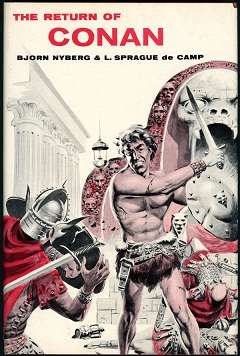The Return of Conan
 First edition | |
| Author | Björn Nyberg and L. Sprague de Camp |
|---|---|
| Cover artist | Wallace Wood |
| Country | United States |
| Language | English |
| Series | Conan the Barbarian |
| Genre | Sword and sorcery Fantasy novel |
| Publisher | Gnome Press |
Publication date | 1957 |
| Media type | Print (hardback) |
| Pages | 191 pp |
The Return of Conan is a 1957 fantasy novel written by Björn Nyberg and L. Sprague de Camp featuring Robert E. Howard's sword and sorcery hero Conan the Barbarian. It was first published in hardcover by Gnome Press and in paperback by Lancer Books as part of the collection Conan the Avenger in 1968; in this form it has been reprinted a number of times since by various publishers. It has also been translated into Japanese, German and Spanish.
Plot summary
In the kingdom of Aquilonia, a year of peace for King Conan and his new queen Zenobia is broken when the latter is abducted by a demon. Conan learns from the wizard Pelias of Koth that the eastern sorcerer Yah Chieng of Khitai is responsible, and begins a quest to recover her, little realizing that the fate of the world as well as Aquilonia rests on the outcome of the contest.
Chronologically, The Return of Conan falls between Howard's novel The Hour of the Dragon (also known as Conan the Conqueror), and the four short stories collected as Conan of Aquilonia.
In the both hardcover Gnome Press edition and the paperback Lancer/Ace edition of the Conan stories, The Return of Conan follows Robert E. Howard's novel Conan the Conqueror; it is the final volume chronologically in the Gnome edition (though one additional volume, Tales of Conan, contains stories issued out of sequence), while in the Lancer/Ace edition it is followed by the short stories collected as Conan of Aquilonia.
Reception
Everett F. Bleiler reported that the novel was "not very good."[1]
Trivia
The Return of Conan was only the second Conan novel ever written, the first being Howard's The Hour of the Dragon. Nyberg, a Swedish fan of Howard's Conan tales, was inspired enough by them to pen the story in a language not even his own. De Camp's contribution was largely to smooth off the rough edges of the resulting text.
Ward Brown noted that "Under a commonly-held theory, Conan manifested Howard's idealized self-image, the larger-than-life hero he would have liked to be in an impossibly perfect world. Reading 'The Return of Conan' one gets the clear impression that Nyberg added himself, his own idealized self-image, placing himself at Conan's side as Rolf - the Scandinavian Viking-type comrade-in-arms, who suddenly appears when the hero stands at bay against impossible odds in the palace of the King of Turan."[2]
Intervention of Crom
The present book in unique among Conan books - both the original Howard Canon and thevarious later additions - in featuring a direct intervention by the Cimmerian god Crom. While habitually using Crom's name as an expletive, Conan rarely prays or calls upon that god for help. As repeatedly stated by Conan, Crom is a reclusive god, who gives his Cimmerians the strength to fight and for the rest expects them to take care of themselves - and Conan feels fine with that. Crom's reason for making a big exception and directly intervening to save Conan in this case is not explicated.
References
- ↑ Everett F. Bleiler, The Guide to Supernatural Fiction, Kent State University Press, 1983, p.387
- ↑ Ward A. Brown, "Who Created Heroic Fantasy, and Why?" in Margaret Cohen-Wheatly, "Essays on Twentieth Century Popular Culture"
- Chalker, Jack L.; Mark Owings (1998). The Science-Fantasy Publishers: A Bibliographic History, 1923-1998. Westminster, MD and Baltimore: Mirage Press, Ltd. p. 305.
- Laughlin, Charlotte; Daniel J. H. Levack (1983). De Camp: An L. Sprague de Camp Bibliography. San Francisco: Underwood/Miller. pp. 85–86.
| Preceded by Conan the Conqueror |
Gnome Conan series (chronological order) |
Succeeded by Tales of Conan |
| Preceded by The Hour of the Dragon |
Complete Conan Saga (William Galen Gray chronology) |
Succeeded by Conan the Great |